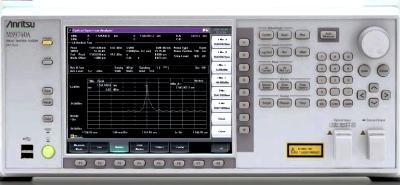
|
|
The Anritsu MS9740A supports the performance and functions for evaluating all active optical devices, including SFP, XFP, and SFP+ modules, as well as optical transceivers and DFB optical sources. It has seven application modes (DFB-LD, FP-LD, LED, PMD, Opt. Amp, WDM, LD Module) matching the measurement target. For example, at evaluation of LD characteristics, analysis items and methods can be tailored to the spectrum, such as a single DFB-LD spectrum, multiple discrete-wavelength FP-LD, wideband LED, etc. Specifications. Wavelength measurement range: 600 nm to 1750 nm. Wavelength accuracy: ±20 pm (1520 nm to 1620 nm, Resolution: 0.03 nm to 0.2 nm), ±100 pm (1520 nm to 1620 nm, Resolution: 0.5 nm, 1.0 nm). Wavelength stability: <= ±5 pm. Wavelength linearity: ±20 pm (1520 nm to 1620 nm). Setting resolution: 0.03, 0.05, 0.07, 0.1, 0.2, 0.5, 1.0 nm; (RBW: 3 dB optical filter: transmission bandwidth). Level accuracy: ±0.4 dB (Wavelength: 1310 nm/1550 nm, Input: –10 dBm, Resolution: >=0.1 nm). Level stability: ±0.02 dB (1 min, Resolution: >= 0.1 nm, Input: -23 dBm, 1550 nm, no polarization fluctuation). High dynamic range: 70 dB (1 nm from peak wavelength), 60 dB (0.4 nm from peak wavelength), 42 dB (0.2 nm from peak wavelength). Normal dynamic range: 62 dB (1 nm from peak wavelength), 58 dB (0.4 nm from peak wavelength), 42 dB (0.2 nm from peak wavelength). Optical return loss: >= 35 dB (1300 nm/1550 nm). Sampling point: 51, 101, 251, 501, 1001, 2001, 5001, 10001, 20001, 50001. Supported optical fiber: 10 µm/125 µm SM fiber (ITU-T G.652), 50 µm/125 µm GI fiber. Optical connector: User replaceable; FC, SC, ST, DIN, LC. Display: 800 × 600 dots, 8.4 inch SVGA color LCD
|